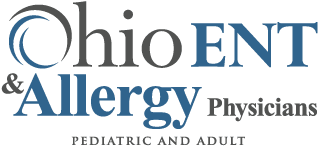Provided By: Evan Tobin, MD
Everyone deals with a sensation of a stuffy or blocked nose from time to time. Usually we know why this is happening—we may have a cold, springtime allergies are here, etc. We are designed to breathe through the nose. It is uncomfortable to us to feel a sensation of congestion. This can also affect our sense of smell and our ability to appreciate flavors. Chronic mouth breathing over a long period of time can lead to dental problems. And for children it can lead to misalignment of the teeth and they can develop bite problems. Nasal congestion can contribute to snoring and sleep apnea as well.
Sometimes nasal blockage or congestion becomes more recurrent or chronic or its cause is unknown. This will be a brief discussion of a variety of things that can cause nasal congestion, how they are diagnosed and treated and which may be serious enough to require a trip to your PCP or even a specialist.
Basic understanding of the nose and sinuses
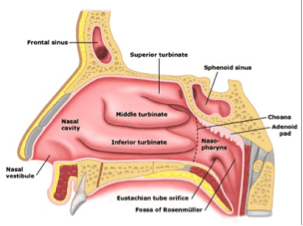
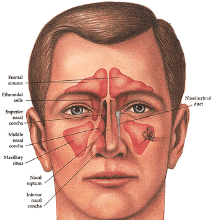

Knowing the parts of the nose helps to understand what can occur to cause blockage of the nasal passages.
The nasal passages provide filtration, humidification and warming of inhaled air on its way to the lungs. The nasal septum divides the nasal passages. It is usually fairly midline. If it is off of the midline it is referred to as a deviated. Most people have a slight deviation of the septum. The nasal turbinates are natural swellings in the nasal passages allowing for heat exchange, humidification and filtering of the air. Filtering occurs by particles sticking to a thin layer of mucus which covers the nasal turbinates. This mucus is produced by the sinuses. The mucus is constantly in motion, being swept to the back of the nasal passage by tiny fibers called “cilia” and into the throat where the mucus is swallowed. Particles are trapped in the mucus, including bacteria and viruses which are killed in stomach acids. The adenoids are located in the back of the nasal passage. They contribute to the immune system in children but can pose problems if they become too large.
Here are some of the common causes of nasal stuffiness
Acute upper respiratory infection (“common cold”)
The cause is a viral infection. One of many hundreds of viruses can cause this. The many types of viruses is why we don’t become immune to every virus and we continue to get colds every year. These are more common in the winter months when we are confined indoors and can more easily spread the virus which is passed around by direct contact or droplet spread from coughs and sneezes. Adults usually get 2-3 colds per year and younger children can get 6-10 per year as their immune systems are developing.
Symptoms include, scratchy or sore throat, cough, runny nose and sometimes low grade fever. The nose is congested because of swelling of the nasal turbinates and excessive mucus production. Also, the viral infection damages the cilia, so the mucus does not move properly and collects. This results in runny nose, post nasal drainage and cough. This leads to further swelling and more congestion.
Treatment is intended to treat symptoms. We simply don’t have medications to treat most viruses. Nasal saline rinses (Neti pot or NeilMed® sinus rinse), saline nasal spray, OTC nasal steroid sprays (Flonase,® Nasocort®), Tylenol®/Motrin®, mucus thinners and decongestants (Mucinex® or Mucinex-D®) can all help. These treatments help to thin and clear out mucus and decrease inflammation and swelling. Decongestant nose sprays can be helpful but should not be used for longer than 3 days to prevent “rebound swelling”, making the problem worse. Other medications are available and oftentimes your pharmacist can provide excellent advice.
Antibiotics given within 10-14 days don’t usually help because bacteria are not present during this time period. Symptoms worsening after 10 days or lasting longer than 14 days can mean that a bacterial infection is present. Antibiotics can be helpful then. It is advisable that parents consult with their child’s pediatrician before starting any over-the-counter medication for the first time. This is especially true in younger children.
Warning signs: high fever, severe headache, swelling around eyes, vision change, shortness of breath. Persistent symptoms should all prompt a visit to PCP or urgent care.
Allergies or Allergic Rhinitis
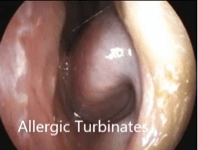 Some people react to particles in the air. These particles, called “allergens” include pollen from various plants, dust, mold or pet dander. Allergies occur when the allergens are inhaled into the respiratory tract of allergic people. The particles cause cells in the nose to release histamine, which then leads to the symptoms of sneezing, running nose and nasal congestion. Some patients wheeze from asthma — asthma and rashes are sometimes related to allergies. Allergies can be seasonal or year-round depending on what the patient is allergic to.
Some people react to particles in the air. These particles, called “allergens” include pollen from various plants, dust, mold or pet dander. Allergies occur when the allergens are inhaled into the respiratory tract of allergic people. The particles cause cells in the nose to release histamine, which then leads to the symptoms of sneezing, running nose and nasal congestion. Some patients wheeze from asthma — asthma and rashes are sometimes related to allergies. Allergies can be seasonal or year-round depending on what the patient is allergic to.
Many OTC meds are available. These will improve most of the symptoms of allergies including congestion. These include antihistamines (Claritin®, Allerga®, Zyrtec®). Sometimes these are combined with a decongestant (with a “-D” in the name). Some older antihistamines like Benadryl® are effective but are sedating. Saline spray or rinses are very helpful to clean out the allergy particles and mucus. OTC nasal steroid sprays can be extremely effective but must be used daily to be effective. Though decongestants can help, these are not ideal for daily use as they can raise blood pressure and cause other side effects. Decongestant nose sprays are to be avoided for treatment of allergies because they cause much more harm than benefit if used over time.
Avoidance of allergy exposure is extremely helpful. For this reason a referral to an allergist for allergy testing can be very beneficial to lead to improved symptoms. There are also other prescription allergy medications which might be prescribed. Some patients will benefit from “desensitization” of their allergies with allergy shots. Stronger sprays are available by prescription. Newer “biologic” medications are now available for severe cases of allergy and asthma. These will provide benefit to the most challenging patients who may have not responded to other treatments. Always consult with your PCP before starting OTC medications for your child or yourself if you’re on other medications.
Over time, severe allergies can cause significant problems in the nose and sinuses, including the development of nasal polyps (see below). Asthma flare-ups can also become worse over time. Some people can have allergies that are so severe that they can develop life-threatening anaphylactic reactions. For these reasons, patients with allergies that are not well-controlled will benefit by an allergy evaluation. It is advisable that parents consult with their child’s pediatrician before starting any over-the-counter medication for the first time. This is especially true in younger children.
Sinus infections


Sinus infections occur when the sinuses are blocked long enough for mucus to become infected with bacteria. This can occur with a viral cold, frequent allergies or any other condition that leads to blockage of the nose. Some patients are genetically predisposed to developing sinus problems. Symptoms of a sinus infection include: nasal drainage, facial pressure, nasal congestion, cough, decreased sense of smell, ear fullness. The symptoms of a viral upper respiratory tract infection are nearly identical to a sinus infection, but more severe and last longer. In most patients, the viral cold does not progress to a bacterial infection. This is considered if the symptoms last longer than 10 to 14 days.
Treatment of a sinus infection
The same medications that help with the symptoms of a viral upper respiratory tract infection will help a sinus infection (please refer to that section above). If symptoms are not improving or if they seem severe, seeing your physician or an urgent care physician is necessary. Antibiotics or steroids (prednisone) may be prescribed. Medicated nasal rinses may be prescribed. In general antihistamines do not help unless allergies are present.
There are two types of sinus infections: recurrent infections which come and go and chronic infections which never leave.
Newer medications are being developed to treat the inflammation that contributes to the development of sinus infections in some patients. These medications are similar to medications that are used for asthma, allergies and chronic dermatologic conditions — which all have similar causes.
Surgery is also an option for patients who continue to have problems. Surgery can improve symptoms and allow for additional treatment options such as antibiotic or steroid sinus irrigations. Nasal and sinus surgery used to have “a bad reputation“. This is based on the earlier types of surgery that were performed. Most of the time today, the recovery is very manageable and nasal packing is not required.
Warning signs of a sinus infection
Sinus infections can be severe and even life-threatening. If a sinus infection is not improving or if other symptoms develop including high fever, severe headache, facial swelling, or vision change, the patient should call their primary care doctor or present to the emergency department for evaluation and treatment.
Other causes of blockage of the nasal passages
In addition to the conditions discussed above, there are a variety of conditions that can lead to chronic blockage of the nasal passage in both children and adults. Many of these conditions have familiar sounding names but are still somewhat confusing to the patient. Here are a few of those (refer to diagrams below for further information):
Deviated nasal septum: The nasal passages are divided by a thin piece of bone and cartilage called the nasal septum. Most patients have a “deviated nasal septum“. Minimal deviation of the septum does not cause problems and in fact may be somewhat beneficial, helping the nose to filter air. If the septum is severely off-center it can block the nasal passages and make the patient feel congested all of the time. This can also lead to the development of sinus problems. Occasionally headaches can be associated. This problem can occur after previous nasal trauma or for unknown reasons. Some patients are born with this. This problems is correctable.
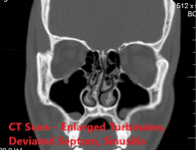
Turbinate enlargement: The nasal turbinates help those two filter warm and humidified air. They swell with inflammation from infection or allergies. Because they are very vascular, they can swell more when gravity affects them. This is why one sometimes feels more congested on the side of the nose that is toward the pillow during a cold or allergy flare-up, while lying in bed. In some cases they remain chronically swollen, requiring medical or even surgical treatment.
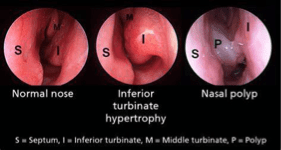
Nasal polyps: These are benign growths that occur in cases of prolonged inflammation in the nasal passages and sinuses. They can be associated with allergies or sinus infections. In some cases the cause is not known. They can become large enough that they completely block both nasal passages, leading to a vicious cycle of infection, inflammation and further polyp formation. In very rare cases polyps can be aggressive or even cancerous. Polyps can also be associated with a condition called cystic fibrosis. Any suspicion of polyps requires further evaluation.
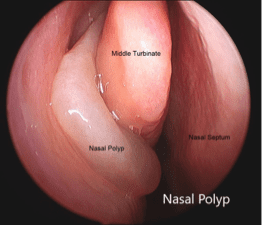
Adenoid enlargement: The tonsils and adenoids are part of the immune system. They usually quietly do their job but they can also cause problems. When adenoids become enlarged they can cause chronic nasal congestion, usually in children but sometime adults. This can lead to mouth breathing and a chronic runny nose. It can contribute to the development of dental or orthodontic problems. They can also cause blockage of the eustachian tube and lead to ear infections. Adenoid enlargement should be suspected in any child with chronic nasal problems. Adenoid enlargement in adults can be a sign of more serious problems and always requires further evaluation.
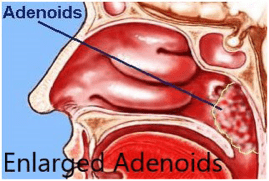

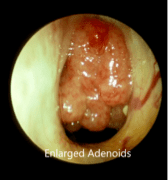
Nasal foreign body: Children are curious and will sometimes put foreign bodies in their ears or nose. If this is not witnessed, a nasal foreign body can slowly cause problems. Symptoms include chronic runny nose from one side, chronic bad breath, cough and blockage of one side of the nose. The symptoms can slowly develop and can be attributed to allergies or common cold. Patients have been seen with nasal foreign body that have been present for years in some cases. Most of the time a nasal foreign body will not cause severe symptoms but it can rarely be aspirated into the lower airways and cause significant problems, including pneumonia. Any child with persistent nasal symptoms should have further evaluation.

Nasal/sinus tumors: These are very rare. When first developed they cause typical nasal and sinus symptoms including blockage of the nose, drainage or bleeding and facial pressure. These tumors can be benign or malignant. The earlier they are diagnosed the more successful the treatment will be. Any persistent nasal or sinus blockage in adults or children should have further evaluation if those symptoms do not improve with treatment.
Overuse of nasal decongestant sprays: These sprays are very effective for short-term use, treating viral colds or a severe allergy flare-up. They should not be used for longer than 2 to 3 days. Longer use can cause symptoms of “rebound congestion”, making the original symptoms even worse. If they are used for a prolonged period of time they can lead to destruction of the tissues in the nose, including perforation of the nasal septum. This is a very difficult problem to correct.
Sleep apnea can be associated with nasal congestion. A blocked nose can lead to snoring and even obstructed breathing during sleep. Patients who have been diagnosed with sleep apnea may not respond well to usual treatment if they cannot breathe properly through their nose.
In summary, there are many conditions that can cause a feeling of blockage of the nose. The most common causes include a common cold, allergies and enlargement of the adenoids. Many of these can be treated successfully with over-the-counter medications with guidance from the patient’s primary care physician or pharmacist. Persistent symptoms should lead to further evaluation and sometimes a referral to an ENT doctor or allergist. Any evaluation and testing should allow for correct diagnosis. Testing may include a simple office endoscopy, office CAT scans, allergy testing or sleep apnea testing. These are covered by insurance. Further testing might lead to an unknown suspected diagnosis allowing more effective treatment.
Prescription medications can be very helpful. Newer medications are being developed for nasal and sinus problems as well as allergies and asthma that will lead to significant improvement in quality of life.
In some cases surgery may be necessary. These surgeries have improved significantly over the last 20 years. Post-operative discomfort is usually mild, packing is usually not required and the recovery is fairly quick. Success rates are very high. The allergists, ENT surgeons and sleep doctors at Ohio ENT and Allergy Physicians would be happy to evaluate you or a family member if any of these problems are present.
